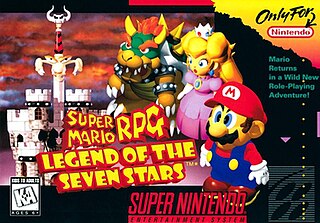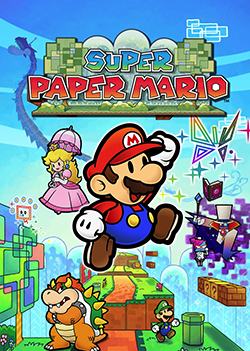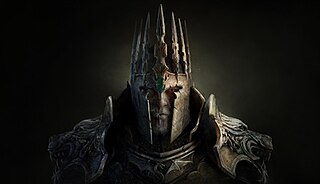
Super Mario RPG: Legend of the Seven Stars is a 1996 role-playing game developed by Square and published by Nintendo for the Super Nintendo Entertainment System (SNES). It was the final Mario game published for the SNES. The game was directed by Chihiro Fujioka and Yoshihiko Maekawa, produced by Shigeru Miyamoto, and scored by Yoko Shimomura.

Paper Mario is a 2000 role-playing game developed by Intelligent Systems and published by Nintendo for the Nintendo 64 home video game console. Paper Mario is the first game in the Paper Mario series. First released in Japan in 2000 and then internationally in 2001, Paper Mario was later re-released for Nintendo's Wii Virtual Console in July 2007, the Wii U Virtual Console in April 2015, and the Nintendo Switch Online + Expansion Pack on December 10, 2021.

Crystalis is a 1990 action role-playing action-adventure video game produced by SNK for the Nintendo Entertainment System. The original Nintendo Entertainment System version has been re-released via the SNK 40th Anniversary Collection on Nintendo Switch, PlayStation 4, Windows, and Xbox One.
Enix Corporation was a Japanese multimedia publisher who handled and oversaw video games, manga, guidebooks, and merchandise. It was founded in 1975 by Yasuhiro Fukushima as Eidansha Boshu Service Center, initially as a tabloid publisher and later attempting to branch into real estate management. Beginning in 1982, Enix began publishing video games. Three notable early collaborators were designers Yuji Horii and Koichi Nakamura, and composer Koichi Sugiyama. Horii, Nakamura and Sugiyama would all work on the 1986 role playing video game (RPG) Dragon Quest for the Family Computer; one of the earliest successful RPGs for consoles, it spawned a franchise of the same name which remains Enix's best-known product.
Dragon Quest Monsters is a spin-off series of the Dragon Quest games. Primarily developed by Tose and published by Square Enix, it sets the player in a medieval/fantasy world filled with magic, monsters and knights. Unlike the original Dragon Quest games, the player's character does not do any of the fighting in battles; instead the player has to rely on capturing, breeding and raising monsters to do the fighting for them. The concept originated from Dragon Quest V (1992). The character and monster designs are by Dragon Ball creator, Akira Toriyama. The series spans several handheld gaming systems, and each game has received positive reviews from critics. The series' gameplay has been compared to Pokémon.

Paper Mario: The Thousand-Year Door is a 2004 role-playing game developed by Intelligent Systems and published by Nintendo for the GameCube. The Thousand-Year Door is the second game in the Paper Mario series following Paper Mario, and is part of the larger Mario franchise. In the game, when Mario and Princess Peach get involved in the search for a mystic treasure that holds great fortune, Peach is kidnapped by an alien group called the X-Nauts; Mario sets out to find the treasure and save the princess.

Suikoden II is a role-playing video game developed and published by Konami for the PlayStation video game console and the second installment of the Suikoden video game series. It was released in late 1998 in Japan, 1999 in North America, and in 2000 in Europe. The game features a vast array of characters, with over 100 recruitable characters, of which over 40 are usable in combat.

Torneko: The Last Hope is a 1999 role-playing video game for the PlayStation. The game was co-developed by Chunsoft and Matrix Software and published by Enix. In Japan, the game was ported to the Game Boy Advance in 2001.

Suikoden is a role-playing video game published by Konami. It is the first installment of the Suikoden series. Developed by Konami Computer Entertainment Tokyo, it was released initially in 1995 for the PlayStation in Japan. A North American release followed one year later, and a mainland European release came the following April. The game was also released for Windows and Sega Saturn in 1998, but only in Japan.

Super Paper Mario is a 2007 action role-playing game developed by Intelligent Systems and published by Nintendo for the Wii. It is the third installment in the Paper Mario series and the first Mario game on the Wii. The game follows Mario, Peach, Bowser, and Luigi as they attempt to collect Pure Hearts and stop Count Bleck and his minions from destroying the universe.

Moon: Remix RPG Adventure is a role-playing adventure game developed by Love-de-Lic and first published in 1997 by ASCII Entertainment for the PlayStation in Japan. Moon is set within a fictional role-playing game where "the hero" has wreaked destruction, killing hundreds of creatures and looting homes. The player takes on the role of a supporting character in this world, attempting to undo the damage done by the hero. Moon has been praised by critics for how it parodies the conventions and tropes of role-playing games.

Ys Seven is a 2009 action role-playing game developed by Nihon Falcom. An installment in the Ys series, it was first released in Japan for the PlayStation Portable in September 2009. Xseed Games released the game in 2010 in North America in August, and Europe in November. The game was later released in Australia in February 2013. It was also released for Windows in China in June 2012, and worldwide by Xseed Games in August 2017.

Xenoblade Chronicles is an action role-playing game developed by Monolith Soft and published by Nintendo for the Wii. Initially released in Japan in 2010, it was later released in the PAL regions in 2011 and in North America in 2012. A port for the New Nintendo 3DS was released in 2015, and a remaster for the Nintendo Switch, titled Xenoblade Chronicles: Definitive Edition, was released in May 2020. Xenoblade Chronicles is the first entry in the Xenoblade Chronicles series, a subseries which forms part of the larger Xeno metaseries. Although it lacks direct narrative connections to previous Xeno games, like them, it incorporates aesthetic and narrative elements from both fantasy and science fiction. The game features navigation through an open world split into zones, side-quests tied to party members' affinity, and a real-time action-based battle system which incorporates Shulk's ability to see brief glimpses of the future.
While the early history and distinctive traits of role-playing video games (RPGs) in East Asia have come from Japan, many video games have also arisen in China, developed in South Korea, and Taiwan.
Paper Mario is a video game series and part of the Mario franchise, developed by Intelligent Systems and produced by Nintendo. It combines elements from the role-playing, action-adventure, and puzzle genres. Players control a paper cutout version of Mario, usually with allies, on a quest to defeat the antagonist, primarily Bowser. The series consists of six games and one spin-off; the first, Paper Mario (2000), was released for the Nintendo 64, and the most recent, a remaster of 2004's Paper Mario: The Thousand-Year Door (2024), for the Nintendo Switch.

Omori is a 2020 role-playing video game developed and published by indie studio Omocat. The player controls a mute hikikomori teenage boy named Sunny and his dream world alter-ego Omori. The player explores both the real world and Sunny's surreal dream world as Omori, either overcoming or suppressing his fears and repressed memories. How Sunny and Omori interact depends on choices made by the player, resulting in one of several endings. The game's turn-based battle system includes unconventional status effects based on characters' emotions. Prominently portraying concepts such as anxiety, depression, psychological trauma, and suicide, the game features strong psychological horror elements.

Monark is a 2021 Japanese role-playing game developed by Lancarse for the PlayStation 4, PlayStation 5 and Nintendo Switch. It was localized and ported to Microsoft Windows by NIS America in February 2022. The game received mixed reviews from critics.

Garden Story is an action role-playing game developed by Picogram and published by Rose City Games. The game was released for macOS, Windows, and Nintendo Switch on August 11, 2021, and for Xbox One on July 12, 2022. Limited Run Games announced that physical copies would be distributed in Q3 2022.

Sea of Stars is a 2023 role-playing video game by Sabotage Studio. The game was released for Windows, Nintendo Switch, PlayStation 4, PlayStation 5, Xbox One, and Xbox Series X/S and is set thousands of years before Sabotage Studio's previous game The Messenger (2018). In the game, players take control of two heroes named Valere and Zale, who use the power of the sun and moon to fight against an alchemist. Sea of Stars features puzzle-solving and turn-based combat, with the player able to control up to six characters. The game was well received critically and commercially.

King Arthur: Knight's Tale is a tactical role playing video game developed and published by NeocoreGames. It was released for Windows in 2022, and PlayStation 5 and Xbox Series X/S in 2024. It is a dark fantasy retelling of Arthurian legend in which players control Mordred.

















